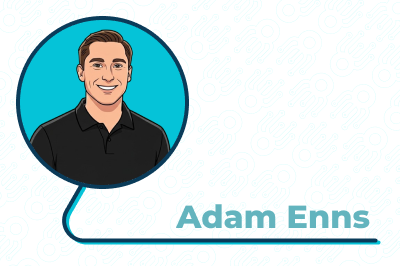Water leaks might seem like small annoyances. In strata living they can quickly spiral into major financial and insurance headaches. From flooded hallways and units to six-figure deductibles, the risks are real. Adam Enns of Integrity Risk Reduction explains why leak detection technology has become essential for strata corporations in British Columbia.
Adam Enns did not stumble into leak detection. His journey began when his uncle, a building maintenance director, grew tired of constant water damage and started researching solutions. After two years of testing, they deployed certified leak detection in several BC buildings. Today, Adam works with Integrity Risk Reduction, helping protect more than $1.3 billion in property across the province.
Why strata communities should care about leak detection
In British Columbia, most insurance claims in strata corporations come from water damage. Deductibles have skyrocketed, with some buildings now facing upwards of $1 million water damage deductibles after repeated incidents. These costs ultimately become the responsibility of individual owners. Many who may be forced to buy extra coverage or risk paying hefty bills out of pocket.
The most common sources of water damage come from the following:
- Aging appliances such as dishwashers and fridges
- Leaking kitchen faucets
- Old plumbing
- Human error, like forgetting to shut off a bathtub
The troubling reality is that most of these losses are preventable. Education combined with modern leak detection systems can significantly reduce claims. Yet many strata owners and managers are unaware that these technologies even exist.
Modern leak detection technologies
Leak detection systems have advanced beyond simple alarms. Modern tools are now smart, precise, and highly customizable. Flow sensors, for example, can identify abnormal water usage and shut off supply instantly. They are capable of catching leaks as small as two ounces per minute. Rope-style sensors are often placed under appliances like fridges, dishwashers, or in mechanical rooms, where they trigger automatic shut-offs if water is detected.
To reduce false alarms, magnetic switch sensors add an extra layer of reliability, especially in busy areas where equipment may be moved or disturbed. Connectivity has also improved. Local LoRaWAN hubs remove the need for Wi-Fi by wirelessly linking sensors across entire floors or even whole buildings. Finally, automatic shut-off valves provide a strong safeguard by cutting water to the entire property in less than 30 seconds, with manual overrides available for added control.
For insurers, full-building shut-off systems remain the gold standard. For homeowners, user-friendly features such as smartphone apps and remote fobs make it easy to monitor, schedule, and manage water usage with confidence.
Inside the walls: protecting plumbing from within
Surface leaks are only part of the story. Many catastrophic water losses start inside aging copper pipes hidden behind drywall. Adam described two treatments that can extend pipe life and prevent pinhole leaks:
- Sodium silicate treatment (Leak Shield): This ceramic coating seals pinholes while reducing copper levels in drinking water. It is safe and commonly used in toothpaste and food products.
- Polyphosphate additives: Effective in some cases, but environmental and health concerns make them less attractive. These additives can contribute to algae blooms and release hidden pipe contaminants.
Choosing the right treatment depends on the building’s needs, but both options can reduce the risk of catastrophic pipe failure.
ROI and the insurance equation
The cost of installing leak detection ranges from about $1,000 for a home setup to $8,000 per unit in high-end strata buildings. While that sounds steep, the payback period is typically only 2.5 to 4.5 years thanks to reduced insurance premiums and fewer claims.
One standout example is Verona, a Vancouver strata. After installing a whole-building leak detection system, their deductible dropped from $500,000 to $75,000. Annual premiums fell by $173,000, and residents avoided mandatory increases to personal insurance.
The benefits go beyond numbers. Leak detection reduces disruption, prevents emergency hotel stays, and may even boost resale values. For condo buyers, “leak detection system included” is quickly becoming a selling point on par with upgraded amenities.
Barriers to adoption
Why isn’t every building using it? According to Adam, the biggest challenge is not cost, but awareness. Many owners simply don’t know these systems exist, and managers often juggle so many priorities that leak prevention slips down the list.
To address this, Integrity Risk Reduction has partnered with insurers and lenders to subsidize system installations, making it easier for entire buildings to adopt the technology. Certified systems built in Canada, backed by Health Canada/NSF approval, and supported by local teams are especially attractive to buyers who want assurance of warranty coverage and fast service.
Modern systems also avoid Wi-Fi dependency, instead relying on LoRaWAN and 4G backups to ensure uninterrupted protection. This eliminates concerns about connectivity and creates a more reliable safeguard for strata corporations.
The future of strata water safety
Adam emphasized that leak detection is not just about technology. It is about reducing the massive financial and logistical impact that water losses create for strata owners and managers.
Water damage will always be a risk in shared buildings, but leak detection is shifting the narrative. Instead of reactive claims and rising premiums, strata communities now have tools to take control.
Water does not wait for permission. Without leak detection, a small drip can turn into a disaster that can costs thousands. With the right system in place, strata corporations can protect residents, preserve property value, and reduce insurance costs.
As Adam puts it, a preventive measure may not be glamorous. But it is always better than a massive insurance claim.

